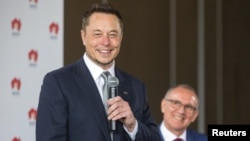South Australia has picked Tesla to install the world’s largest grid-scale battery, which would be paired with a wind farm provided by France’s Neoen, in a major test of the reliability of large-scale renewable energy use.
South Australia, the fifth-biggest state with a population of 1.7 million, has raced ahead of the rest of the country in turning to wind power. Its shutdown of coal-fired plants has led to outages across the eastern part of the nation, driving up energy prices.
The drawback to South Australia’s heavy reliance on renewables has been an inability to adequately store that energy, leading to vulnerabilities when the wind doesn’t blow.
The project is designed to have a storage capacity of 129 megawatt-hours, which is enough to light up 30,000 homes, a Tesla spokesman told Reuters.
100 days or it’s free
Under the terms of the agreement, Tesla must deliver the 100-MW battery within 100 days of a contract being signed or it’s free, matching a commitment made by Tesla Chief Executive Officer Elon Musk in a Twitter post in March.
“There will be a lot of people that will look at this, ‘did they get it done within 100 days? Did it work?’” Musk told reporters in South Australia’s capital city of Adelaide. “We are going to make sure it does.”
The 100-day deadline will begin within a few weeks, a political source said, after a connectivity agreement is reached between South Australia, Telsa, Neoen and the Australian Energy Market Operator.
Musk and a spokesman for South Australia Premier Jay Weatherill declined to reveal the cost of the project.
Musk said a failure to deliver the project in time would cost his company “$50 million or more,” without elaborating.
Lithium ready
The battery, designed to provide emergency back-up power if a shortfall in energy is predicted, will be built on site in South Australia, a spokesman for the state government said.
Tesla said in a statement that upon completion by December 2017, the system would be the largest lithium-ion battery storage project in the world, overtaking an 80 megawatt-hour power station at Mira Loma in Ontario, Calif., also built using Tesla batteries.
The neighboring state of Victoria is also seeking 100 megawatt-hour battery capacity, to be installed by January.
Lithium-ion batteries have been in widespread use since about 1991, but mostly on a small scale, such as in laptops and cell phones.
A typical lithium-ion battery can store 150 watt-hours of electricity in 1 kilogram of battery, representing more than double the capacity of nickel batteries.
Its proponents have been pushing to use lithium batteries on a grander scale.
“For lithium technology to take off on a global scale, they clearly need the storage capacity to make sure renewables can deliver 24 hours a day, seven days a week,” said Adrian Griffin, a geologist who specializes in lithium extraction.
Dozens of companies from 10 countries, including privately owned Lyon Group, working with U.S. power company AES Corp, had expressed interest in the South Australian project.










